Handling Flooding and Storm Damage in the Landscape
go.ncsu.edu/readext?432142
en Español / em Português
El inglés es el idioma de control de esta página. En la medida en que haya algún conflicto entre la traducción al inglés y la traducción, el inglés prevalece.
Al hacer clic en el enlace de traducción se activa un servicio de traducción gratuito para convertir la página al español. Al igual que con cualquier traducción por Internet, la conversión no es sensible al contexto y puede que no traduzca el texto en su significado original. NC State Extension no garantiza la exactitud del texto traducido. Por favor, tenga en cuenta que algunas aplicaciones y/o servicios pueden no funcionar como se espera cuando se traducen.
Português
Inglês é o idioma de controle desta página. Na medida que haja algum conflito entre o texto original em Inglês e a tradução, o Inglês prevalece.
Ao clicar no link de tradução, um serviço gratuito de tradução será ativado para converter a página para o Português. Como em qualquer tradução pela internet, a conversão não é sensivel ao contexto e pode não ocorrer a tradução para o significado orginal. O serviço de Extensão da Carolina do Norte (NC State Extension) não garante a exatidão do texto traduzido. Por favor, observe que algumas funções ou serviços podem não funcionar como esperado após a tradução.
English
English is the controlling language of this page. To the extent there is any conflict between the English text and the translation, English controls.
Clicking on the translation link activates a free translation service to convert the page to Spanish. As with any Internet translation, the conversion is not context-sensitive and may not translate the text to its original meaning. NC State Extension does not guarantee the accuracy of the translated text. Please note that some applications and/or services may not function as expected when translated.
Collapse ▲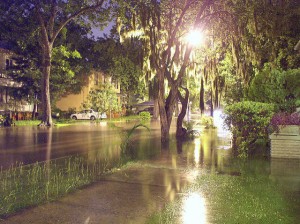
Image by B CC-BY-NC
Flooding can be devastating with lasting effects on landscapes and gardens.
Triage
- Do not make snap decisions. Many deciduous plants will lose their leaves as a strategy for coping with flooding but will leaf out again over time.
Document
- When it is safe, take photographs to document:
- how high the water came
- damage to plants and property
- any foreign substances washed into your landscape
Clean Up
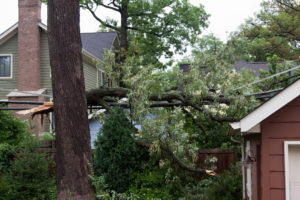
Image by Chris CC-BY-SA
- Safety First. Beware of down power lines, broken glass, and other hazards. Stay out of floodwater.
- Do not enter until the landscape has dried out. Walking or driving on saturated soil can cause compaction.
- Check for potential sources of contamination including pesticides, household chemicals, oil, fertilizers, or machinery that were stored in or around the garden that may have spilled into the garden or gotten into floodwaters.
- Remove trash, debris and any uprooted plants. Separate garbage from yard waste and place it in a spot designated for pick up.
- Downed branches and trees are dangerous, often not responding as anticipated, leading to further expensive and unnecessary damage to the tree and the person. Hire an Expert.
- If plants are covered in salt from a storm surge, rinse them in clean water as soon as possible (unless the rain does this for you)
- If plants are covered with sediment, first wet plants with plain water and then spray a solution of one tablespoon of dishwashing liquid per gallon of water to rinse silt off plants. After one minute rinse. Do not leave the detergent solution on for more than a minute. If the silt is thick and the recipe above is not sufficient, consider adding a teaspoon of dishwasher rinsing agent. DO NOT use a pressure washer on plants.
- Do not fertilize plants after the flood. Many will be dormant.
- Remove sources of standing water or use Mosquito dunks to eliminate breeding spots for mosquitoes.
Scouting
- Stressed plants are more susceptible to insect and disease damage. Be on the lookout for wood boring insects, canker causing fungi as well as root and crown rot fungi that thrive in moist soil.
Managing Edible Plants and Gardens Exposed to Flood Water
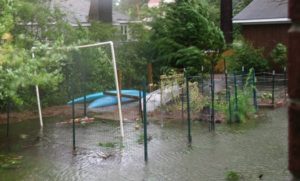
image by Carl Crozier
- The first consideration is personal safety. Floodwater may contain bacterial, viral and parasitic contaminants including raw sewage from septic tanks, animal feces and dead animals from agriculture or pets particularly E. coli, Listeria and Vibrio. In addition, chemical contaminants could have been washed in from a variety of sources. Exposure can occur through eating soil (including soil adhering to fruits, and vegetables); breathing volatiles and dust; absorbing contaminants through the skin; and eating fruits and vegetables that have absorbed contaminants.
- Stay out of floodwater
- Wear a mask, gloves, boots or close-toed shoes and other protective equipment
- Wash your hands frequently during and after garden cleanup.
- Minimize contamination inside the house by removing clothes, shoes, and tools used during garden cleanup prior to entering the home.
 Food safety: What to eat, what to compost and what to discard. Floodwaters may be contaminated with raw sewage so do not eat leafy greens or root crops that are difficult to wash and are eaten raw. Crops that can be boiled pose less risk from viral or bacterial contamination however, neither cooking nor canning will remove the risk of chemical contamination. More information about food preparation and safety.
Food safety: What to eat, what to compost and what to discard. Floodwaters may be contaminated with raw sewage so do not eat leafy greens or root crops that are difficult to wash and are eaten raw. Crops that can be boiled pose less risk from viral or bacterial contamination however, neither cooking nor canning will remove the risk of chemical contamination. More information about food preparation and safety.- Newly seeded gardens rarely survive a flood.
- Allow the soil to dry out before working since working wet soils causes compaction.
- Consider moving the bed to higher ground or growing in a raised bed.
- Check your water source to determine if it has been contaminated
- Test the soil for likely chemical contaminants. Minimizing Risks of Soil Contaminants in Urban Gardens
- Add several inches of compost and turn the soil 18-24 inches deep. Amend the soil to a pH of 6.5 – 7.0 making some heavy metals less available.
- Mulch pathways to minimize dust.
- Consider planting a cover crop prior to the next food crop: Winter Cover Crops Summer Cover Crops.
- Do not harvest food for 90-120 days after flood water recedes.
- More information on Vegetable, Herb and Fruit Gardens Exposed to Floodwater
- 75-minute video on managing flooded vegetable gardens, featuring experts from NC State Extension and Duke Superfund Research Center

Image by Charles Anderson CC-BY-NC
Landscape
- Managing Storm Damaged Trees in the Landscape
- The healthier the plant, the shorter the time underwater, the higher the tolerance of the species to low soil-oxygen levels, the sandier the soil, and the more dormant the plant the more likely it is to survive flooding. Some may not show the full signs of flood stress for several years. Leaves will turn yellow and drop, branch dieback will begin at the tips. Plant stress will cause poor growth and increased insect and disease pressure. Wet soils encourage root and crown diseases like Fusarium Phytophthora, Pythium and Rhizoctonia solani.
- Cover exposed roots replacing lost soils with organic matter which will replace lost soil microbes as well as slow-release nutrients to promote plant health.
- Remove excess silts and soils covering tree trunks and crowns.
- Improve site drainage.
- Do not fertilize while plants are recovering as this can make the plant more vulnerable to insect and disease damage.
- Prune only dead, diseased or broken branches during the first year after the storm. The plant will need as many leaves as possible to produce food to recover. How to Hire a Tree Care Professional.
- Native and well-adapted plants including trees, shrubs, perennials, and hardy bulbs will likely survive. Crape myrtles (Lagerstroemia), Chinese Holly (Ilex rotunda) have also survived flooding.
- Plants often killed by flooding include Japanese Holly (Ilex crenata), Japanese Boxwood (Buxus microphylla var. japonica), Indian Hawthorn (Rhaphiolepis), Nandina (Nandina), hybrid junipers (Juniperus), and hybrid azaleas (Rhododendron).
- Symptoms of Flood damage:
- Leaves: Yellowing or browning, premature fall color, curling, pointing downward, wilt, drop, smaller new leaves.
- Branches: dieback, sprouts on stems or trunk.
- Plant: windthrow (uprooted in heavy wind), gradual plant decline, death.
- Young, recently planted, small shrubs and trees can often be saved.
- Mature trees should be removed.
- Replanting: see these lists of woody plants tolerant of wet conditions and tolerant of wind. Avoid those injured by flooding.
Lawn
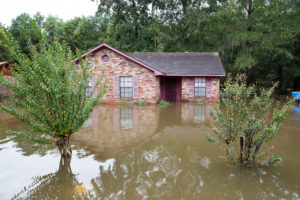
Image by North Charleston CC-BY-SA
- Saturated soils and debris, silt and soil left after the water recedes can kill lawns. Turfgrass species vary in submersion tolerance and bermudagrass is more tolerant than most. The level of injury depends on water temperature and depth, whether any leaves extend above the water surface, and the amount of time the turf is submerged. Soil and debris two or more inches deep should be removed from the turf as soon as possible after flooding. It is not possible to remove the layer of soil or debris consider core aerifying when the weather is favorable.
- Turfgrass Management after Hurricanes – Scroll to the bottom for information on managing Turfgrass that has been submerged.
Additional Resources
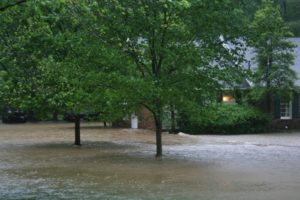
image by Kyle Jones CC-BY-NC-ND
- Food Safety
- Food Safety for School and Community Gardens (NCSU)
- FSMA Produce Safety Rule Water Requirements (Produce Safety Alliance)
-
Guidance for Industry: Evaluating the Safety of Flood-affected Food Crops for Human Consumption (US Food & Drug Administration)
- Post Storm Management
- Managing the Impact of Floodwater Contaminants on Soil and Produce in Residential, Community, and School Vegetable Gardens
- Post-Hurricane Resources (Duke)
- What to Do Following a Hurricane (UF IFAS)
- Dealing with Storm-damaged Trees in the Landscape – (LSU)
- Effects of Flooding on Woody Landscape Plants (eXtension)
- After The Flood: Garden and Landscape Plants (Purdue)
- Urban Forest Hurricane Recovery Program Series (UFA)
- Soil
- Duke Superfund Research Center Resources for Gardens (Duke)
- Map of potential contaminants (Duke)
- Minimizing Risks of Soil Contaminants in Urban Gardens (NC State)
Resources
This document is based on work shared by Dr. Carl Crozier, Dr. Ben Chapman, Dr. Liz Shapiro-Garza, Catherine Kastleman, Bryan Luukinen, Samuel Cohen, Steven Yang, and Charlotte Glen.


